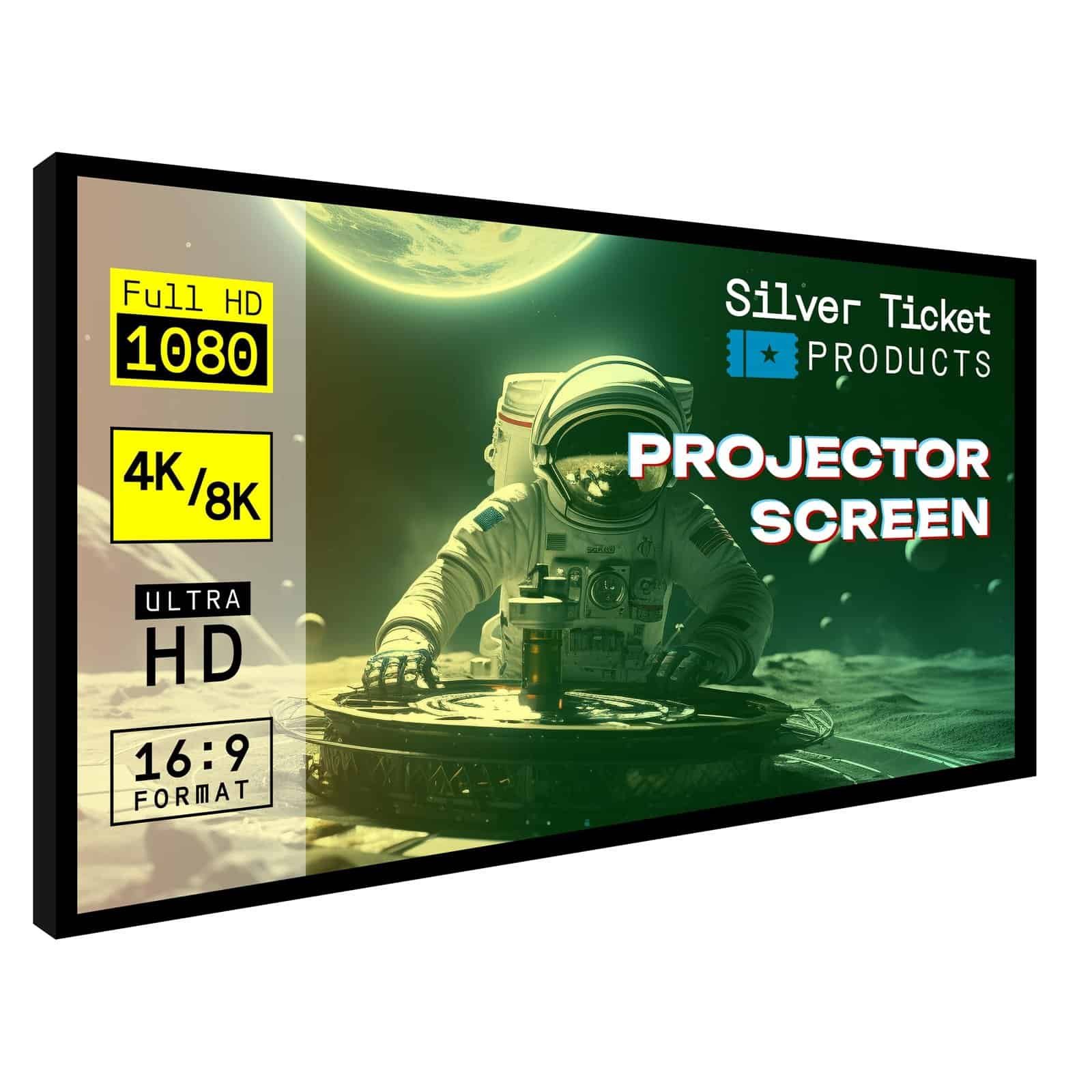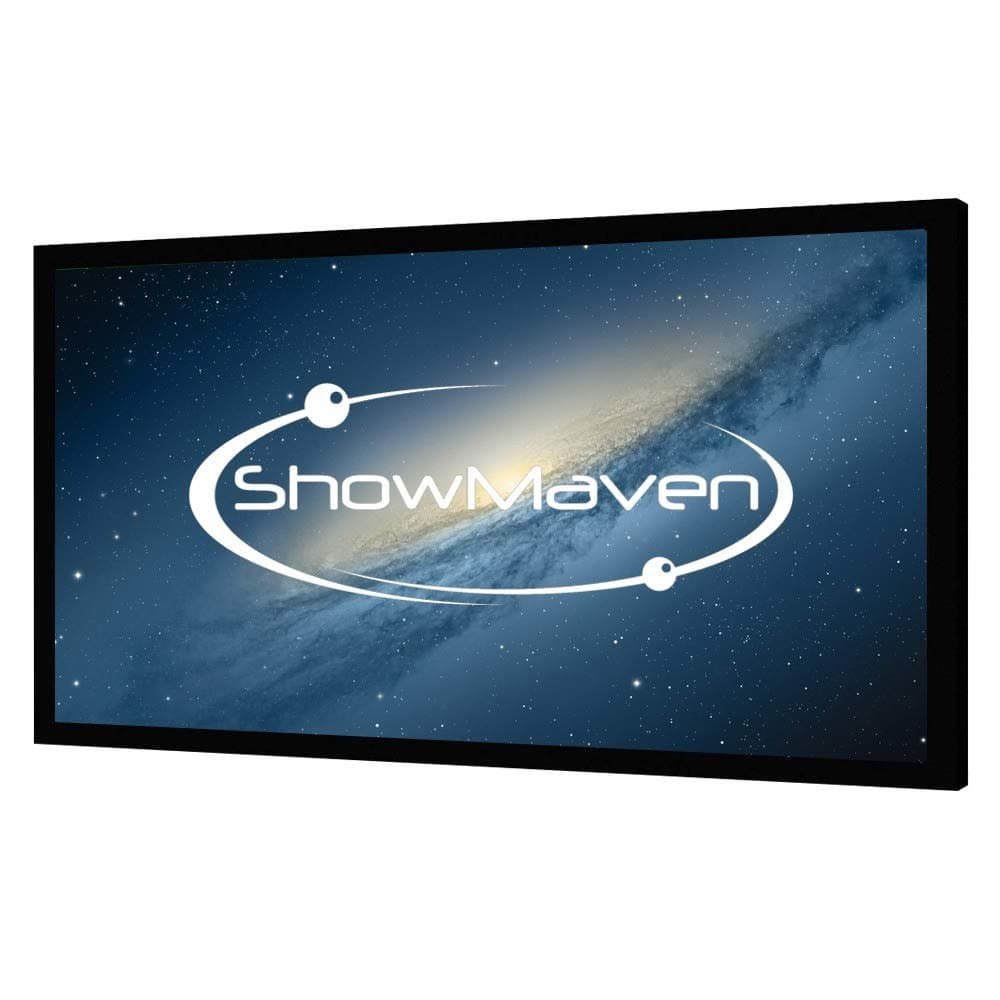Projector screens enhance viewing quality by providing a dedicated, optimized surface for displaying images and videos. Unlike projecting onto walls or other surfaces, proper screens are designed with specific materials and coatings that improve brightness, contrast, and color accuracy. Fixed frame projector screens offer the highest image quality among screen types because they maintain a perfectly flat, wrinkle-free surface that stays permanently tensioned.
Fixed frame screens consist of a rigid aluminum frame with screen material stretched taut across it, then mounted to a wall like a large picture frame. This permanent installation eliminates the sagging, wrinkles, or waves that can affect portable or retractable screens. The consistently flat surface ensures uniform image quality across the entire viewing area, making these screens ideal for dedicated home theaters or media rooms where picture quality is the top priority.
When choosing a fixed frame screen, the most critical factors are screen size, gain rating, and material type. Screen size should match your projector’s throw distance and room dimensions. Gain rating affects brightness and viewing angles, with 1.0 gain providing neutral brightness and wider viewing angles, while higher gain screens boost brightness but narrow the optimal viewing zone. We researched and analyzed dozens of fixed-frame projector screens to identify the models that deliver exceptional image quality and value.
Best Fixed Frame Projector Screens
We evaluated dozens of fixed-frame projector screens based on build quality, screen material, and overall value. Our testing focused on image clarity, ease of installation, and long-term durability to identify the top performers.
Silver Ticket STR-169120 Fixed Frame Screen

We recommend this screen for home theater enthusiasts seeking professional image quality without the premium price tag.
Pros
- Tension rod system eliminates wrinkles and speeds up assembly significantly
- Black velvet wrapped frame absorbs stray light and prevents ugly shadows
- Wide 160-degree viewing angle maintains image quality from any seating position
Cons
- 33-pound weight requires two people for wall mounting
- Not compatible with certain ultra-short-throw projectors
- White material lacks acoustic transparency for behind-screen speakers
After setting up our Silver Ticket STR-169120, we immediately noticed how the tension rod system transforms the assembly experience. The screen material slides into pockets around each edge, then rods secure everything perfectly flat. This design saved us considerable time compared to other screens that require tedious tucking and stretching.
The 120-inch viewing area delivers impressive color reproduction with its 1.1 gain white surface. We tested various content from different angles and found no resolution loss even at extreme viewing positions. The black velvet frame wrapping makes a noticeable difference by absorbing light spillover from our projector.
Wall mounting proved straightforward once we had assistance with the weight. The aluminum frame feels substantial without being overly bulky, and the beveled edges create a clean finished appearance. We appreciated the horizontal adjustment capability of the mounting brackets for fine-tuning alignment.
Image quality exceeded our expectations for this price range. Colors appear vibrant and natural, while the perfectly tensioned surface eliminates any distracting ripples or sags. The wide viewing angle means everyone in our theater room enjoys the same crisp picture quality regardless of seating location.
ShowMaven Fixed Frame Screen

This screen delivers solid performance at a budget-friendly price, though the installation process requires patience and careful attention to detail.
Pros
- Sturdy aluminum frame with velvet edges creates a professional theater appearance.
- PVC material stays completely flat without wrinkles or waves affecting image quality
- Black backing prevents light bleed-through for crisp edge definition
Cons
- The spring attachment system makes screen installation surprisingly challenging.
- Assembly instructions lack clarity for the wall mounting process
- Screen material feels delicate during the stretching phase
We found the ShowMaven screen transforms any room into a legitimate home theater setup. The black velvet frame absorbs stray projector light effectively, creating sharp borders that rival much more expensive options.
Installation proved more demanding than expected. The spring-loaded attachment system requires a significant force to stretch the screen material into position. We recommend starting from the center and working outward rather than beginning at the corners.
Once properly mounted, this screen handles 4K content beautifully. The 1.1 gain provides bright, vibrant colors without hotspotting. We tested it with both short-throw and traditional projectors with excellent results across the 160-degree viewing angle.
The aluminum frame construction feels reassuring after assembly. At nearly 28 pounds, this isn’t going anywhere once mounted. We appreciate the inclusion of spare parts, which proves the manufacturer understands the installation challenges.
AWOL VISION 120″ Fixed Frame Screen

This screen delivers exceptional picture quality and easy assembly, making it an excellent choice for serious home theater enthusiasts.
Pros
- Significantly improves image sharpness and color accuracy compared to wall projection.
- The tensioning rod system makes installation straightforward with minimal tools required.
- Wide 170-degree viewing angle ensures excellent picture quality from any seating position.
Cons
- Assembly can take up to two hours and benefits from having a second person
- Some units may develop corner wrinkles during the tensioning process
- Screen size might be too large for smaller rooms without proper planning
We immediately noticed the improvement in picture quality when switching from wall projection to this fixed-frame screen. The matte white surface eliminates the texture issues we experienced with painted walls and delivers much more vibrant colors.
The assembly took us about 90 minutes working as a team. The aluminum frame feels solid, and the spring tensioning system works well once you get the hang of it. We appreciated the clear instructions, though getting the fabric perfectly taut requires some patience.
The 120-inch size creates an impressive viewing experience in our dedicated theater room. We tested it with both 4K content and gaming, finding the wide viewing angle particularly beneficial for group movie nights. The black border design helps maintain contrast even with ambient light present.
Maintenance has been simple so far – occasional dusting keeps the surface clean. The PVC material feels durable enough to handle regular use without showing signs of wear after several months of regular viewing.
Buying Guide
When selecting a fixed frame projector screen, we need to consider several key factors that directly impact our viewing experience.
Screen size should match our room dimensions and seating distance. We typically want the screen width to equal about one-third of our viewing distance.
Screen Material Options
| Material Type | Best For | Key Benefits |
|---|---|---|
| Matte White | General use | Even light distribution |
| Gray | Dark rooms | Better contrast |
| Acoustic | Behind speakers | Sound transparency |
| ALR (Ambient Light Rejecting) | Bright rooms | Reduces glare |
Gain ratings affect brightness and viewing angles. We should choose 1.0-1.3 gain for most setups. Higher-gain screens provide more brightness but narrow our optimal viewing angle.
Frame Construction
We need to examine the frame material and assembly method. Aluminum frames offer durability and lightweight construction. Steel frames provide extra stability for larger screens.
Tensioning systems keep the screen surface flat. We should look for screens with multiple tension points across all edges.
Installation Requirements
We must measure our wall space carefully before purchasing. Fixed frame screens require permanent mounting and adequate clearance around the frame.
Aspect ratio should match our projector’s native format. Common ratios include 16:9 for home theater and 16:10 for presentations.
Edge borders come in different widths and colors. Black borders help define the image area and improve perceived contrast.